I caught up earlier this week on the drama Castles in the Sky about Robert Watson Watt and his invention of radar. My mum had been a young (18) radio location operator on the outskirts of London during the Second World War and liked to talk about it, so I was very interested, and thoroughly enjoyed the programme. It turns out there is an active Robert Watson Watt society which is raising a statue to him in his birthplace, Brechin. I knew nothing about him before this.

Kathleen Coyle is in this group of early radar operators
The story very much brought to mind two excellent books. One is Tim Harford’s [amazon_link id=”0349121516″ target=”_blank” ]Adapt[/amazon_link], about the structures that enable significant innovation – the ability to accommodate mavericks and mistakes, the importance of skunkworks and so on. The other is [amazon_link id=”0141042826″ target=”_blank” ]Most Secret War[/amazon_link] by R.V.Jones, about scientific intelligence during the second world war, including the decryption and encryption work at Bletchley Park. It’s also concerned with this question of how ideas work and fruitful failure can mesh with bureaucracy and order, and with the deep problem of information, the signal and the noise.
[amazon_image id=”0141042826″ link=”true” target=”_blank” size=”medium” ]Most Secret War (Penguin World War II Collection)[/amazon_image]
